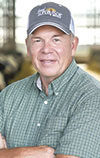I have been a dairy nutritionist for over 33 years, and I am usually the first to know when one of my dairies is having hoof health problems. While many issues with cow health point back to nutrition, I have found that hoof problems, more often than not, stem from environmental causes rather than nutrition.
If nutrition is to blame, you typically see issues occurring in all four hooves, not just one or two.
From milk production to reproduction, hoof problems can negatively impact nearly every aspect of a cow’s life, making it easy to point a finger at the nutritionist when things start going wrong. However, we can’t attempt to fix hoof problems if we don’t understand what those problems are. Is it digital dermatitis (DD)? Sole ulcers? White-line lesions?
Next, we need to take a closer look at why a certain hoof problem is occurring. While this may come as a surprise, the true root of hoof problems can be determined when records are documented in an electronic system.
Does your hoof trimmer keep detailed records on trim day? If your nutritionist asks him what types of lesions he’s seeing and which zones are affected, can your trimmer provide the answers? If there’s no data to fall back on, the nutritionist’s hands are tied. We need accurate and up-to-date records, but what we often find is something else.

Many times, asking for trim records produces a manure-stained notebook found in some lonely corner of the barn. This type of hoof health record-keeping system often lacks substance and provides little to no direction, making it quite difficult for the nutritionist, or anyone else for that matter, to offer valuable input.
When requesting information on hoof health, a nutritionist might receive any of the following: no data, illegible data or data filled with meaningless terms and phrases like “abscess” or “soft hooves” or abbreviations or numerical systems that read like a foreign language to a layperson. What good is information if no one can understand it, let alone summarize or analyze it?
In some cases, nutritionists are fortunate to receive useful data from the dairy’s trimmer – data that includes proper diagnoses, graphs and charts that clearly illustrate the problems at hand, helping us better understand the herd’s hoof health situation.
Some trimmers even email hoof health reports to the nutritionist and veterinarian. This is like a dream come true for a nutritionist, making it easier for us to help solve hoof issues. We can pass that information on to other knowledgeable parties to gain insight on particular problems.
Hoof records must be shared with all of your farm’s key contributors to keep everyone on the same page and working toward the same goals. Communication between the trimmer, owner, herd manager, veterinarian, nutritionist and other pivotal players on the management team is incredibly important.
Because success on the dairy is tightly entwined with cows having healthy feet, it’s critical to review hoof health data during monthly or quarterly meetings. This way, problems can hopefully be resolved by the team before becoming detrimental to the dairy.
For example, when one farm’s monthly lesion graph showed an increase in the number of digital dermatitis lesions, the management team drilled down to discover what was causing the issue. Lesions had started to increase after the dairy changed its herdsman and discontinued the footbath routine. Once they reimplemented the footbath program, DD levels in the herd dropped significantly.
On another occasion, a dairy’s trimmer reported a rise in the number of blocks being applied. The data was sent off to a consultant for analysis, who pinpointed when the issue (an increase in sole ulcers) began and questioned if there was a change in sand sources during the month of April. It turned out there was. The dairy had been using reclaimed sand from the separator instead of new sand. Sand sources were corrected, and the incidence of lesions returned to a level more typical for this herd.
After one farm noticed a surge in the levels of front hoof white-line lesions in zone 2, an investigation was conducted to find out why. Based on lesion type and location, an overaggressive crowd gate was suspected to be the cause. The milking staff was retrained in how to properly operate the gate, and the problem went away.
Each lame event has a cost associated with it, hurting the dairy financially and its goal of producing high levels of milk in an efficient and cost-effective manner. Therefore, it’s important for trimmers to present data in a fashion that allows everyone to identify problems easier and implement solutions quicker.
The trimmer needs to offer more than, “I saw a lot of abscesses; I had to block a lot of cows,” which isn’t helpful for solving problems. A chuteside data recording system eliminates manure-stained papers and helps the trimmer more quickly identify and express problems to the management team.
Reliable data is crucial for achieving and maintaining excellent hoof health. The professional hoof trimmer who keeps detailed records and shares that information with others becomes a valid problem solver on the team and makes a real difference in helping reduce or eliminate lameness on the dairy.
Without good data, we’re just guessing. Solid hoof records put your nutritionist and other team members in a position to continually improve hoof health, which is vital to keeping cows productive and profitable. ![]()

-
Keith Sather
- Dairy Nutritionist/Owner
- KS Dairy Consulting Inc.
- Email Keith Sather




